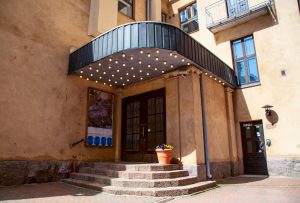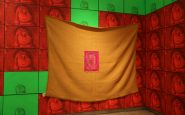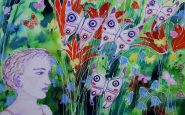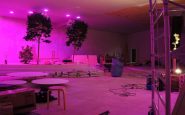« Indietro
Il mondo dell’arte al tempo della pandemia/6. Intervista a Henna Harri della Galleria Hippolyte
Il 06/06/2020
Abbiamo intervistato Henna Harri, direttrice della storica e rinomata Galleria Hippolyte, luogo di riferimento da più di quattro decadi per la fotografia contemporanea e non solo. In un elegante via centrale di Helsinki, all'interno di un vecchio cinema, si sono ieri riaperte le porte dello spazio espositivo dove è nuovamente visitabile la video installazione di Laura Böök The Group That Cannot Sing (immagine di copertina) e le sperimentazioni di Kira Leskinen con la serie Chroma. La galleria è presente anche nella 'culture factory' di Korjaamo, un'interessante realtà che avvicina l'arte al pubblico (ve ne avevamo parlato qui).
Q: Hippolyte is an elegant space in the center of Helsinki, whose activities are focused on photography and its extensions. Can you tell the Italian audience something about your identity and history?
A: If you ask of me personally, I’ve got an MA from Art Education in Lapland University, and have not been so much educating but managing and coordinating in the field of contemporary art in Finland. I’ve been in Photographic Gallery Hippolyte and the Association of Photographic Artists now for four years, and before that in several state, foundation and association based organisations, just before this in Aalto University for five and half years. What comes to identity, I’ve been struggling a bit after leaving teaching at Aalto, and moving back to organizing and managing. It seems that I am a teacher at heart, and enjoyed the turmoil it brings.
On the other hand it is such a pleasure to now be at the core of visual arts scene in Helsinki. The grassroot level organizations are the ones in closest contact with the artists and their work. Hippolyte has always been known for its good programme, and of a progressive view on how to approach the audience. As Hippolyte was founded by the photographic artists themselves and has a history of 42 years, with this continuity it is one of the pillars of contemporary art in Finland. After the artists had run the gallery for ten years or so, they also founded an association, the Association of Photographic Artists, which runs the gallery now, and is the member organization for them. Along with the print makers’, painters’, sculptors’ and media/audio/performance artists’ associations it is one of the five national organizations that form the Artists' Association of Finland. We work with the artists, and we speak for the artists.
Q: The pandemics has forced the closure of cultural activities also in Finland. What was on display at the time of the closure?
A: We were exhibiting in two spaces with three exhibitions at the time, in Hippolyte at Yrjönkatu we had Jarno Vesala’s installation I Remembered Otherwise and Paula Saraste’s All Things, Passing, and in Hippolyte Korjaamo in Töölö Photofuss Group with Liminal Spaces. The combination of the Vesala and Saraste exhibitions was fantastic, they both were in midst of the notion of remembering, what do we remember and what do we choose to remember. Vesala’s dark and mysterious installation gave the viewer shivers, and Saraste had retouched the existing images of one man, John Lennon, questioning the relationship of image and existence.
Q: The gallery is going to reopen its activities in few days, together with the museums reopening in Finland. What project will you start with after the lockdown?
A: We will open on the 5th of June [l'intervista è stata realizzata prima della riapertura], and there will be a wonderful project by Laura Böök of the Group That Cannot Sing and Kira Leskinen with her new series Chroma. In Hippolyte Korjaamo we will continue with Liminal Spaces and Photofuss. We will organize two open air workshops just before mid summer for the people who think they cannot sing, but would like to sing no matter what. We’re taking the workshop out in our courtyard to diminish the risk of any infections, and taking eight participants for both.
Q: The future of culture has to be reconsidered, we will have to find a way to live with such a situation for at least another year. How are you organising the gallery, under the practical point of view and in terms of planning of activities. What are the strategies for the reopening?
A: We’ve been in conversation with a whole bunch of other galleries in Helsinki to talk through the critical points, how to organize everything in practice, and also what would be the most sensible and ethical way to deal with the unfortunate cancellations or postponing of the exhibitions, which are of course very hard on the artists but also for us and our audiences too.
The most dense events are the openings, when there can easily be 200 people at the gallery and for the time being we’ve decided to skip them altogether. Smaller measures have been taken to ensure the safety of the audience, we will have a plex shield by the desk between the gallery assistant and the audience, since the lobby of the gallery is small, we will also be cleaning the surfaces more often than usual, and asking people to take the back door on their way out to avoid two way passings at the gallery.
Q: Do you think it is possible to foresee the future of the art market in this new economical stage?
A: Now that all has been cancelled, I can imagine how wide the effects in the cancellations of the art fairs can be, not only for the galleries and the artists but also for all sorts of providers like the printmakers, producers, publishers, you name it! And depending on what happens with the economy in general, how quickly we can pick things up again, is it possible to rethink the flows of goods and money, and to direct buyers to online spaces and substances. Another trend is obviously downsizing and customizing: genuine encounters in galleries by appointment. This is happening already, I’ve noticed.
I’d like to think that if the situation continues for a longer period of time, also the art market will find ways to be present online. I believe in the graving for art, that there is a growing quest for what artists do, new narratives and images for the world we live in.
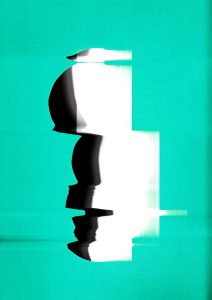
Q: Is there an online initiative, also on social networks, that you liked and want to share with us?
A: We’ve been working with the Museum of Photography on the Photobook of the Year award this spring and have had to reconsider how to show the books to the audience. We’ve had a lovely collaboration with artists Minna Kurjenluoma and Kati Rapia who helped us create images and words online, all in www.photobookaward.fi, only in Finnish unfortunately for now. I’ve been also delighted to see how Gallery Halmetoja, www.galleryhalmetoja.fi, has brought the artists to the fore on their Instagram lives. I add also Wilma Hurskainen’s new art project, where she follows her sister in her last days of pregnancy until the giving birth and the baby being a couple of weeks old, over these strange times and in isolation!
Thanks Henna!
Immagini:
-Copertina>the exhibition of Laura Böök opening on the 5th of June: a still image of the media installation: the Group That Cannot Sing, 2020
-Gallery entrance at Yrjönkatu, Helsinki
-From the Hippolyte Studio Kira Leskinen Chroma exhibition, Tokra, 2018
Q: Hippolyte is an elegant space in the center of Helsinki, whose activities are focused on photography and its extensions. Can you tell the Italian audience something about your identity and history?
A: If you ask of me personally, I’ve got an MA from Art Education in Lapland University, and have not been so much educating but managing and coordinating in the field of contemporary art in Finland. I’ve been in Photographic Gallery Hippolyte and the Association of Photographic Artists now for four years, and before that in several state, foundation and association based organisations, just before this in Aalto University for five and half years. What comes to identity, I’ve been struggling a bit after leaving teaching at Aalto, and moving back to organizing and managing. It seems that I am a teacher at heart, and enjoyed the turmoil it brings.
On the other hand it is such a pleasure to now be at the core of visual arts scene in Helsinki. The grassroot level organizations are the ones in closest contact with the artists and their work. Hippolyte has always been known for its good programme, and of a progressive view on how to approach the audience. As Hippolyte was founded by the photographic artists themselves and has a history of 42 years, with this continuity it is one of the pillars of contemporary art in Finland. After the artists had run the gallery for ten years or so, they also founded an association, the Association of Photographic Artists, which runs the gallery now, and is the member organization for them. Along with the print makers’, painters’, sculptors’ and media/audio/performance artists’ associations it is one of the five national organizations that form the Artists' Association of Finland. We work with the artists, and we speak for the artists.
Q: The pandemics has forced the closure of cultural activities also in Finland. What was on display at the time of the closure?
A: We were exhibiting in two spaces with three exhibitions at the time, in Hippolyte at Yrjönkatu we had Jarno Vesala’s installation I Remembered Otherwise and Paula Saraste’s All Things, Passing, and in Hippolyte Korjaamo in Töölö Photofuss Group with Liminal Spaces. The combination of the Vesala and Saraste exhibitions was fantastic, they both were in midst of the notion of remembering, what do we remember and what do we choose to remember. Vesala’s dark and mysterious installation gave the viewer shivers, and Saraste had retouched the existing images of one man, John Lennon, questioning the relationship of image and existence.
Q: The gallery is going to reopen its activities in few days, together with the museums reopening in Finland. What project will you start with after the lockdown?
A: We will open on the 5th of June [l'intervista è stata realizzata prima della riapertura], and there will be a wonderful project by Laura Böök of the Group That Cannot Sing and Kira Leskinen with her new series Chroma. In Hippolyte Korjaamo we will continue with Liminal Spaces and Photofuss. We will organize two open air workshops just before mid summer for the people who think they cannot sing, but would like to sing no matter what. We’re taking the workshop out in our courtyard to diminish the risk of any infections, and taking eight participants for both.
Q: The future of culture has to be reconsidered, we will have to find a way to live with such a situation for at least another year. How are you organising the gallery, under the practical point of view and in terms of planning of activities. What are the strategies for the reopening?
A: We’ve been in conversation with a whole bunch of other galleries in Helsinki to talk through the critical points, how to organize everything in practice, and also what would be the most sensible and ethical way to deal with the unfortunate cancellations or postponing of the exhibitions, which are of course very hard on the artists but also for us and our audiences too.
The most dense events are the openings, when there can easily be 200 people at the gallery and for the time being we’ve decided to skip them altogether. Smaller measures have been taken to ensure the safety of the audience, we will have a plex shield by the desk between the gallery assistant and the audience, since the lobby of the gallery is small, we will also be cleaning the surfaces more often than usual, and asking people to take the back door on their way out to avoid two way passings at the gallery.
Q: Do you think it is possible to foresee the future of the art market in this new economical stage?
A: Now that all has been cancelled, I can imagine how wide the effects in the cancellations of the art fairs can be, not only for the galleries and the artists but also for all sorts of providers like the printmakers, producers, publishers, you name it! And depending on what happens with the economy in general, how quickly we can pick things up again, is it possible to rethink the flows of goods and money, and to direct buyers to online spaces and substances. Another trend is obviously downsizing and customizing: genuine encounters in galleries by appointment. This is happening already, I’ve noticed.
I’d like to think that if the situation continues for a longer period of time, also the art market will find ways to be present online. I believe in the graving for art, that there is a growing quest for what artists do, new narratives and images for the world we live in.

Q: Is there an online initiative, also on social networks, that you liked and want to share with us?
A: We’ve been working with the Museum of Photography on the Photobook of the Year award this spring and have had to reconsider how to show the books to the audience. We’ve had a lovely collaboration with artists Minna Kurjenluoma and Kati Rapia who helped us create images and words online, all in www.photobookaward.fi, only in Finnish unfortunately for now. I’ve been also delighted to see how Gallery Halmetoja, www.galleryhalmetoja.fi, has brought the artists to the fore on their Instagram lives. I add also Wilma Hurskainen’s new art project, where she follows her sister in her last days of pregnancy until the giving birth and the baby being a couple of weeks old, over these strange times and in isolation!
Thanks Henna!
Immagini:
-Copertina>the exhibition of Laura Böök opening on the 5th of June: a still image of the media installation: the Group That Cannot Sing, 2020
-Gallery entrance at Yrjönkatu, Helsinki
-From the Hippolyte Studio Kira Leskinen Chroma exhibition, Tokra, 2018

